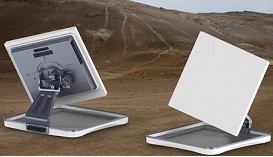Recent satellite innovations open the way for new applications, performance and price points.
Communications satellites were first introduced in the 1960s, making them a very well-established and even somewhat “old” technology. These decades of experience mean that this is also a proven technology with exceptionally high reliability, user flexibility and global reach that extends to even the most remote locations. Recent satellite industry and technology innovations have transformed the satellite solution paradigm and built on the proven base to unlock new applications and cost metrics, including software-defined satellites.
The global satellite industry is currently in its most significant growth and innovation phase to date, with some 17,000 satellite launches planned for the next decade (an increase of 332% over the previous 10-year period). These launches will be for Low Earth Orbit (“LEO”), Medium Earth Orbit (“MEO”) and Geostationary Orbit (“GEO”) constellations which will increase capacity in the “sky” as well as introducing terrestrial technology innovations. The planned LEO constellations alone will add some 200Tbps of satellite capacity – that is, almost 20 times more capacity than the 12Tbps provided by the Seacom submarine cable system.
With this capacity expansion planned for satellite networks in space, we should also consider how ground-based components will evolve and what we can expect, specifically in the mining and industrial environments. To provide additional insights, this article briefly touches on some of the key technology and service innovations found in new satellite solutions. Providing evidence to dispel the outdated myth that satellite is slow, expensive and has a latency problem. This opinion is now obsolete and no longer applies to the new generation satellite services.
Smart Satellite Services
The Twoobii Service as engineered by Q-KON is a Smart Satellite Service that truly delivers seamless enterprise and industrial connectivity to off-grid locations. “Off-grid” in this context refers to operational locations that are not connected to first tier telco grids via fibre or microwave systems.
Satellite has long been a reliable option to connect such locations; what is new is that next generation Smart Satellite Services such as Twoobii have advanced functions and features to deliver video, voice and corporate data connections, plus interoperability with SD-WAN network architectures. With data speeds of up to 20Mbps, equipment rental costs of just R350 per month and service profiles starting at around R1,500 per month, this unlocks new ways to connect remote plants, offices, industrial monitoring and operational facilities.

GEO Satellite Terminal Antenna Innovations
Research and development in antenna technology is driving a new generation of satellite terminals for mobile and tactical deployments. Again, this application is not new; however, the price points of these terminals are completely different, and more importantly, services can now be activated on Geostationary networks such as the Twoobii Smart Satellite Service.
Previously, mobile satellite services could only be implemented on satellite constellations such as INMARSAT which provided reliable communications, but at a premium price point. For next generation services, Terminal Antenna solutions such as StarWIN are compatible with standard Ku-band Geostationary services for easy and cost-effective deployments.
These terminals are ideal for providing communications to project teams at exploration sites, or even for temporary service restoration, disaster recovery options and civil unrest contingency plans. When combined with a “pay-per-use” service bundle, no data costs are incurred when the terminals are not being used, making this a very cost-effective option.

New Portable Phased Array Antenna Technology Terminals from StarWIN.
MEO Next Generation Services
New Medium Earth Orbital constellations, such as the SES-mPower service, are introducing another level of high-capacity and low-latency service to provide connectivity to remote locations. Developed as an alternative to fibre services, the mPower solution can provide data links at up to 1Gbps. With transmission latency of a mere 150msec, this shatters the old myth that satellite has a latency problem.
These MEO services will enable the implementation of completely different network architectures to service even the most remote mining and industrial locations as part of seamless corporate networks.
LEO Next Generation Services
SpaceX’s project Starlink, Project Kuiper from Amazon and OneWeb are all projects focused on developing the Low Earth Orbit constellation sector. While the Starlink project is most often mentioned in the media, the real progress for the South African and African markets has come from OneWeb. Expected to start testing services in Q3 2022. OneWeb will enable broadband connectivity using easy-to-deploy terminals for fixed or mobile applications.
OneWeb terminals will include 5G services for ease of connectivity to user devices in enterprise, industrial and control settings. The network gateway will be implemented in South Africa for seamless network integration with each user’s corporate network.
Conclusions
Current innovations and growth in the GEO, MEO and LEO satellite network constellations sector will make more than 200Tbps of additional data capacity available to the mining and industrial sectors and drive the always-on anywhere requirement for cloud and other business applications.
These next generation satellite constellations have provided the impetus for research and development into new antenna technologies, satellite terminal solutions and the development of new Smart Satellite Services such as Twoobii. Collectively, these technologies offer the mining industry new high-performance connectivity options at dramatically improved price points.
The exponential reduction in launch costs, combined with the development of flexible and scalable software-defined satellites and the implementation of end-to-end Smart Satellite Services, has the potential to redefine the landscape for satellite service implementation, both for South Africa and across the continent.
These enabling trends are being repeated worldwide and will underwrite and endorse the delivery of solutions by niche telco operators like Q-KON Africa – operators with significant experience in designing and delivering specialised solutions for the demanding African environment.
Twoobii is a high-throughput satellite connectivity service, powered by the latest Intelsat platforms and managed by leading satellite engineering enterprise, Q-KON. www.twoobii.com
Q-KON is a first-tier provider of integrated access services, specialising in turnkey telecommunications solutions and value-added distribution, configuration, integration and installation services for Africa. www.qkon.com

